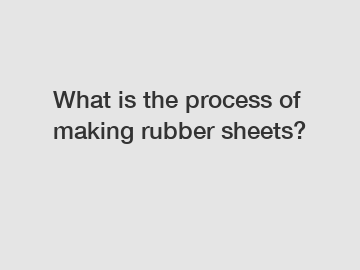What is the process of making rubber sheets?
What is the process of making rubber sheets?
Rubber sheets are widely used across various industries due to their versatility and durability. From automotive parts to industrial seals, rubber sheets play a crucial role in many applications. But have you ever wondered how these sheets are made? In this article, we will delve into the process of manufacturing rubber sheets, exploring the steps involved and the materials used. So, let's dive in!
1. Raw Material Preparation:

To begin the process, high-quality raw materials are needed. Rubber sheets are primarily made from natural rubber or synthetic rubber compound, which is a mixture of various additives, fillers, and chemicals to enhance specific properties. The raw materials are carefully measured and mixed in a machine called a Banbury mixer. This machine ensures a homogeneous blend of the components, resulting in a consistent rubber compound.
2. Mixing and Compound Formation:
Once the raw materials are blended, the rubber compound is transferred to a two-roll mill or an internal mixer. In this step, the compound undergoes intense mixing, which helps to disperse fillers and other additives uniformly. Temperature control during this process is vital to achieve the desired physical properties and avoid premature vulcanization. The mix is continuously worked until the compound becomes smooth and free from any lumps.
3. Sheet Formation:
After the compound is well-mixed, it is ready for the sheet formation stage. There are two common methods for producing rubber sheets – calendering and extrusion. Calendering involves passing the rubber compound between heavy rollers, which apply pressure to shape the material into thin sheets of the desired thickness. On the other hand, extrusion involves pushing the rubber compound through a die, forming continuous sheets with specific widths and thicknesses.
4. Vulcanization:
Vulcanization is a critical step in the manufacturing process that gives rubber its unique properties such as elasticity, strength, and chemical resistance. The rubber sheets are placed in a heated press or an autoclave where they are subjected to elevated temperatures and pressure. During this process, sulfur or other cross-linking agents are added to the compound, causing the rubber molecules to bond together and form a strong, durable network. Vulcanization can take anywhere from a few minutes to several hours, depending on the desired properties and thickness of the rubber sheets.
5. Finishing and Quality Control:
Once vulcanization is complete, the rubber sheets undergo various finishing processes. These include trimming the edges for uniformity, smoothing the surface, and applying coatings or treatments to enhance specific characteristics like chemical resistance or appearance. Additionally, rigorous quality control measures are taken to ensure that the rubber sheets meet the required standards and specifications. This involves conducting tests for physical properties, such as tensile strength, elongation, tear resistance, and hardness.
In conclusion, the process of making rubber sheets involves several stages, from raw material preparation and compound formation to sheet formation, vulcanization, and finishing. Each step requires precision and careful control of various parameters to achieve the desired properties and quality. With these steps in place, industries can rely on rubber sheets for a wide range of applications, including gaskets, seals, vibration control, and much more. The next time you come across a rubber sheet, you will have a better understanding of the complex process behind its creation.
If you want to learn more, please visit our website High Abrasion Resistance Nr Rubber Sheet for Sale, Hammer Top Cow Rubber Mat, High Tensile Strength Nr Rubber Sheet.


